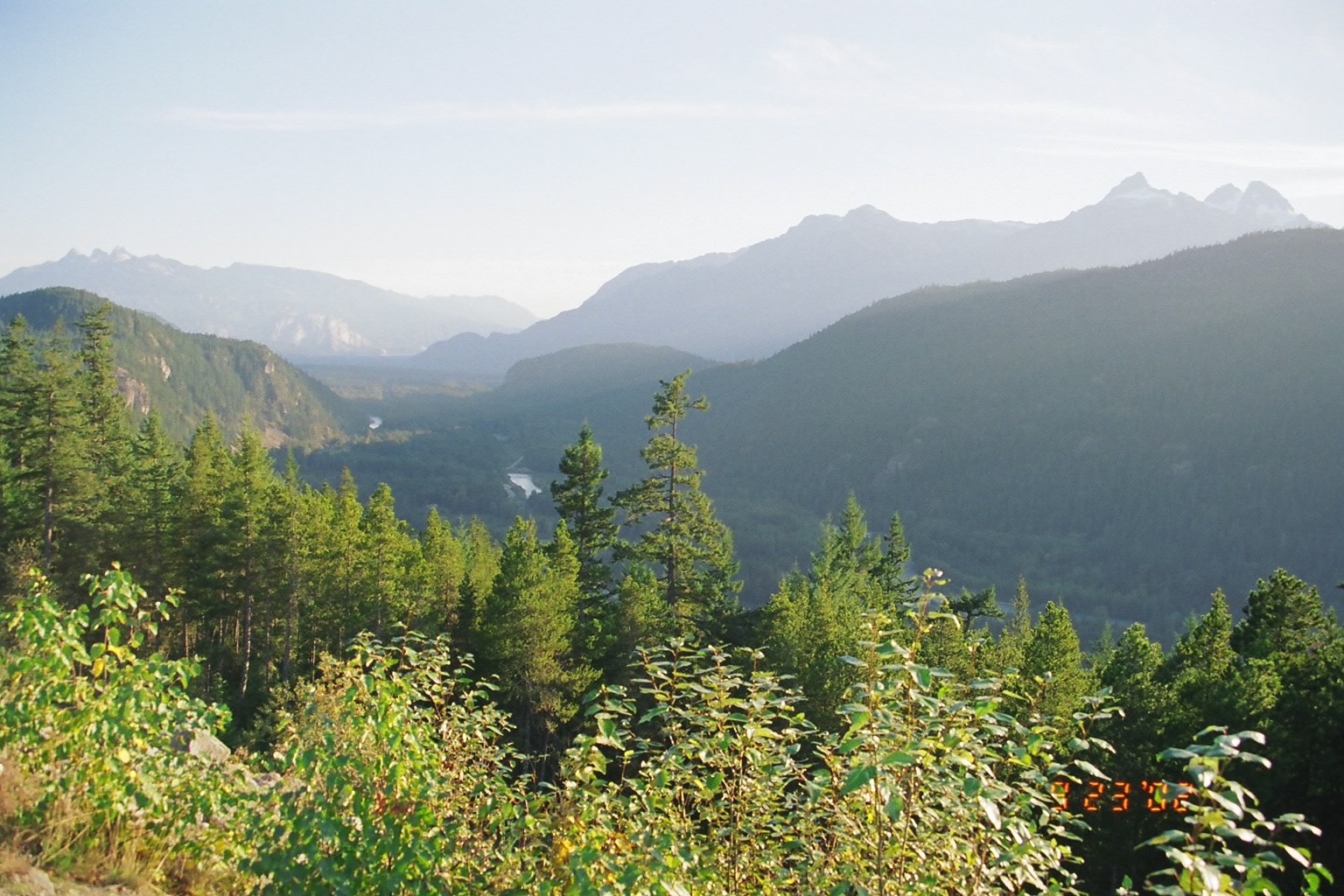|
Mount Pitt
Mount Pitt is a summit in British Columbia, Canada. Description Mount Pitt is located in the McBride Range of the Coast Mountains, and southeast of Whistler in Garibaldi Provincial Park. The remote peak is the fourth-highest point of the McBride Range and 37th-highest peak within the park. Precipitation runoff and glacial meltwater from this mountain's north and east slopes drains to the Lillooet River via Tuwasus Creek, whereas the south and west slopes drain to the Pitt River. Mount Pitt is more notable for its steep rise above local terrain than for its absolute elevation as topographic relief is significant with the summit rising 1,487 metres (4,880 ft) above Tuwasus Creek in and the west aspect rises approximately 1,200 metres (3,937 ft) in . This mountain is located near the head of Pitt River, which is named after William Pitt the Younger (1759–1806), and the mountain's toponym was officially adopted August 14, 1952, by the Geographical Names Boar ... [...More Info...] [...Related Items...] OR: [Wikipedia] [Google] [Baidu] |
William Pitt The Younger
William Pitt (28 May 1759 – 23 January 1806) was a British statesman who served as the last prime minister of Kingdom of Great Britain, Great Britain from 1783 until the Acts of Union 1800, and then first Prime Minister of the United Kingdom, prime minister of the United Kingdom from January 1801. He left office in March 1801, but served as prime minister again from 1804 until his death in 1806. He was also Chancellor of the Exchequer for all of his time as prime minister. He is known as "Pitt the Younger" to distinguish him from his father, William Pitt the Elder, who had also previously served as prime minister. Pitt's prime ministerial tenure, which came during the reign of King George III, was dominated by major political events in Europe, including the French Revolution and the Napoleonic Wars. Pitt, although often referred to as a Tory (British political party), Tory, or "new Tory", called himself an "independent Whig (British political party), Whig" and was generally oppo ... [...More Info...] [...Related Items...] OR: [Wikipedia] [Google] [Baidu] |
Topographic Relief
Terrain (), alternatively relief or topographical relief, is the dimension and shape of a given surface of land. In physical geography, terrain is the lay of the land. This is usually expressed in terms of the elevation, slope, and orientation of terrain features. Terrain affects surface water flow and distribution. Over a large area, it can affect weather and climate patterns. Bathymetry is the study of underwater relief, while hypsometry studies terrain relative to sea level. Importance The understanding of terrain is critical for many reasons: * The terrain of a region largely determines its suitability for human settlement: flatter alluvial plains tend to have better farming soils than steeper, rockier uplands. * In terms of environmental quality, agriculture, hydrology and other interdisciplinary sciences; understanding the terrain of an area assists the understanding of watershed boundaries, drainage characteristics, drainage systems, groundwater systems, water ... [...More Info...] [...Related Items...] OR: [Wikipedia] [Google] [Baidu] |
Two-thousanders Of British Columbia
Two-thousanders are mountains that have a height of at least 2,000 metres above sea level, but less than 3,000 metres. The term is used in Alpine circles, especially in Europe (e.g. German: ''Zweitausender''). The two photographs show two typical two-thousanders in the Alps that illustrate different types of mountain. The Säuling (top) is a prominent, individual peak, whereas the Schneeberg (bottom) is an elongated limestone massif. In ranges like the Allgäu Alps, the Gesäuse or the Styrian-Lower Austrian Limestone Alps the mountain tour descriptions for mountaineers or hikers commonly include the two-thousanders, especially in areas where only a few summits exceed this level. Examples from these regions of the Eastern Alps are: * the striking Nebelhorn (2,224 m) near Oberstdorf or the Säuling (2,047 m) near Neuschwanstein, * the Admonter Reichenstein (2,251 m), Eisenerzer Reichenstein (2,165 m), Großer Pyhrgas (2,244 m) or Hochtor (2,3 ... [...More Info...] [...Related Items...] OR: [Wikipedia] [Google] [Baidu] |
Forger Peak
Forger Peak is a mountain summit in British Columbia, Canada. Description Forger Peak is located southeast of Whistler in Garibaldi Provincial Park. It is part of the McBride Range which is a subrange of the Coast Mountains. Precipitation runoff and glacial meltwater from the mountain's slopes drains north to the Cheakamus River and south to the Pitt River. Forger Peak is more notable for its steep rise above local terrain than for its absolute elevation as topographic relief is significant with the west slope rising 1,223 metres (4,012 ft) in . The mountain is named in association with the officially named Forger Glacier which is a descriptive name for the forging action of the glacier in shaping the local terrain. The first ascent of the summit was made in 1972 by John Clarke and B. Samson. Climate Based on the Köppen climate classification, Forger Peak is located in the marine west coast climate zone of western North America. Most weather fronts originate in th ... [...More Info...] [...Related Items...] OR: [Wikipedia] [Google] [Baidu] |
Mount Sir Richard
Mount Sir Richard is a glaciated summit in British Columbia, Canada. Description Mount Sir Richard is located in the McBride Range of the Coast Mountains, and southeast of Whistler in Garibaldi Provincial Park. It is the highest point of the McBride Range and seventh-highest peak within the park. Precipitation runoff and glacial meltwater from this mountain's south and east slopes drains to the Lillooet River via Tuwasus Creek, whereas the north and west slopes drain into headwaters of the Cheakamus River. Mount Sir Richard is more notable for its steep rise above local terrain than for its absolute elevation as topographic relief is significant with the summit rising 1,880 metres (6,168 ft) above Tuwasus Creek in less than and 1,380 metres (4,527 ft) above Cheakamus River in . History The mountain's name honors Sir Richard McBride (1870–1917). The toponym was officially adopted September 2, 1930, by the Geographical Names Board of Canada. In 1903, at ... [...More Info...] [...Related Items...] OR: [Wikipedia] [Google] [Baidu] |
The Lecture Cutters
The Lecture Cutters are mountain peaks in British Columbia, Canada. Description The Lecture Cutters is located in the McBride Range of the Coast Mountains, and southeast of Whistler in Garibaldi Provincial Park. It is the third-highest point of the McBride Range. Precipitation runoff and glacial meltwater from this mountain's slopes drains into the Cheakamus River. The Lecture Cutters is more notable for its steep rise above local terrain than for its absolute elevation as topographic relief is significant with the summit rising over 1,200 metres (3,937 ft) above the river in . Etymology The mountain's toponym was officially adopted August 27, 1965, by the Geographical Names Board of Canada as proposed by Dr. Roy Hooley (1924–1996), Alpine Club of Canada and professor of civil engineering at the University of British Columbia. He was accustomed to students skipping his classes, especially members of UBC's Varsity Outdoors Club who regularly climbed in the Garibald ... [...More Info...] [...Related Items...] OR: [Wikipedia] [Google] [Baidu] |
Geology Of British Columbia
The geology of British Columbia is a function of its location on the leading edge of the North American continent. The mountainous physiography and the diversity of the different types and ages of rock hint at the complex geology, which is still undergoing revision despite a century of exploration and mapping. The province's most prominent geological features are its mountain ranges, including the North American Cordillera which stretches from Southern Mexico to Alaska. Terrane theory Terrane theory was first proposed by Jim Monger of the Geological Survey of Canada and Charlie Rouse in 1971 as an explanation for a set of fusulinid fossils that were found in central British Columbia. Rather than suggest that facies changes or seaways were behind this (which were common explanations at the time), the two geologists proposed that the fossils in question had been part of an assemblage of rocks that had migrated across the Pacific Ocean to their present location. This theor ... [...More Info...] [...Related Items...] OR: [Wikipedia] [Google] [Baidu] |
Geography Of British Columbia
British Columbia is the westernmost province of Canada, bordered by the Pacific Ocean. With an area of it is Canada's third-largest province. The province is almost four times the size of the United Kingdom and larger than every United States state except Alaska. It is bounded on the northwest by the U.S. state of Alaska, directly north by Yukon and the Northwest Territories, on the east by Alberta, and on the south by the U.S. states of Washington, Idaho, and Montana. Formerly part of the British Empire, the southern border of British Columbia was established by the 1846 Oregon Treaty. The province is dominated by mountain ranges, among them the Canadian Rockies but dominantly the Coast Mountains, Cassiar Mountains, and the Columbia Mountains. Most of the population is concentrated on the Pacific coast, notably in the area of Vancouver, located on the southwestern tip of the mainland, which is known as the Lower Mainland. It is the most mountainous province of Canada. St ... [...More Info...] [...Related Items...] OR: [Wikipedia] [Google] [Baidu] |
Orographic Lift
Orographic lift occurs when an air mass is forced from a low elevation to a higher elevation as it moves over rising terrain. As the air mass gains altitude it quickly cools down adiabatically, which can raise the relative humidity to 100% and create clouds and, under the right conditions, precipitation. Orographic lifting can have a number of effects, including precipitation, rain shadowing, leeward winds, and associated clouds. Precipitation Precipitation induced by orographic lift occurs in many places throughout the world. Examples include: * The Mogollon Rim in central Arizona * The western slope of the Sierra Nevada range in California. * The western slope of the Wasatch Range in Utah. Specifically the Little and Big Cottonwood Canyons. * The mountains near Baja California North – specifically La Bocana to Laguna Hanson. * The windward slopes of Khasi and Jayantia Hills (see Mawsynram) in the state of Meghalaya in India. * The Western Highlands of Yemen, which rece ... [...More Info...] [...Related Items...] OR: [Wikipedia] [Google] [Baidu] |
Weather Front
A weather front is a boundary separating air masses for which several characteristics differ, such as air density, wind, temperature, and humidity. Disturbed and unstable weather due to these differences often arises along the boundary. For instance, cold fronts can bring bands of thunderstorms and cumulonimbus precipitation or be preceded by squall lines, while warm fronts are usually preceded by stratiform precipitation and fog. In summer, subtler humidity gradients known as dry lines can trigger severe weather. Some fronts produce no precipitation and little cloudiness, although there is invariably a wind shift. Cold fronts generally move from west to east, whereas warm fronts move poleward, although any direction is possible. Occluded fronts are a hybrid merge of the two, and stationary fronts are stalled in their motion. Cold fronts and cold occlusions move faster than warm fronts and warm occlusions because the dense air behind them can lift as well as push the warme ... [...More Info...] [...Related Items...] OR: [Wikipedia] [Google] [Baidu] |
Marine West Coast
An oceanic climate, also known as a marine climate or maritime climate, is the temperate climate sub-type in Köppen classification represented as ''Cfb'', typical of west coasts in higher middle latitudes of continents, generally featuring cool to warm summers and cool to mild winters (for their latitude), with a relatively narrow annual temperature range and few extremes of temperature. Oceanic climates can be found in both hemispheres generally between 40 and 60 degrees latitude, with subpolar versions extending to 70 degrees latitude in some coastal areas. Other varieties of climates usually classified together with these include subtropical highland climates, represented as ''Cwb'' or ''Cfb'', and subpolar oceanic or cold subtropical highland climates, represented as ''Cfc'' or ''Cwc''. Subtropical highland climates occur in some mountainous parts of the subtropics or tropics, some of which have monsoon influence, while their cold variants and subpolar oceanic climates occu ... [...More Info...] [...Related Items...] OR: [Wikipedia] [Google] [Baidu] |
Köppen Climate Classification
The Köppen climate classification divides Earth climates into five main climate groups, with each group being divided based on patterns of seasonal precipitation and temperature. The five main groups are ''A'' (tropical), ''B'' (arid), ''C'' (temperate), ''D'' (continental), and ''E'' (polar). Each group and subgroup is represented by a letter. All climates are assigned a main group (the first letter). All climates except for those in the ''E'' group are assigned a seasonal precipitation subgroup (the second letter). For example, ''Af'' indicates a tropical rainforest climate. The system assigns a temperature subgroup for all groups other than those in the ''A'' group, indicated by the third letter for climates in ''B'', ''C'', ''D'', and the second letter for climates in ''E''. Other examples include: ''Cfb'' indicating an oceanic climate with warm summers as indicated by the ending ''b.'', while ''Dwb'' indicates a semi-Monsoon continental climate, monsoonal continental climate ... [...More Info...] [...Related Items...] OR: [Wikipedia] [Google] [Baidu] |









